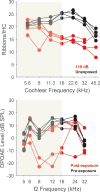Translational issues in cochlear synaptopathy
- PMID: 28069376
- PMCID: PMC5639696
- DOI: 10.1016/j.heares.2016.12.010
Translational issues in cochlear synaptopathy
Abstract
Understanding the biology of the previously underappreciated sensitivity of cochlear synapses to noise insult, and its clinical consequences, is becoming a mission for a growing number of auditory researchers. In addition, several research groups have become interested in developing therapeutic approaches that can reverse synaptopathy and restore hearing function. One of the major challenges to realizing the potential of synaptopathy rodent models is that current clinical audiometric approaches cannot yet reveal the presence of this subtle cochlear pathology in humans. This has catalyzed efforts, both from basic and clinical perspectives, to investigate novel means for diagnosing synaptopathy and to determine the main functional consequences for auditory perception and hearing abilities. Such means, and a strong concordance between findings in pre-clinical animal models and clinical studies in humans, are important for developing and realizing therapeutics. This paper frames the key outstanding translational questions that need to be addressed to realize this ambitious goal.
Keywords: Cochlear synaptopathy; Hidden hearing loss; Noise-induced hearing loss.
Copyright © 2017 Elsevier B.V. All rights reserved.
Figures


References
-
- Altschuler RA, Dolan DF, Halsey K, Kanicki A, Deng N, Martin C, Eberle J, Kohrman DC, Miller RA, Schacht J. Age-related changes in auditory nerve-inner hair cell connections, hair cell numbers, auditory brain stem response and gap detection in UM-HET4 mice. Neuroscience. 2015;292:22–33. - PMC - PubMed
-
- Bing D, Lee SC, Campanelli D, Xiong H, Matsumoto M, Panford-Walsh R, Wolpert S, Praetorius M, Zimmermann U, Chu H, Knipper M, Ruttiger L, Singer W. Cochlear NMDA receptors as a therapeutic target of noise-induced tinnitus. Cell Physiol Biochem. 2015;35:1905–1923. - PubMed
Publication types
MeSH terms
Grants and funding
LinkOut - more resources
Full Text Sources
Other Literature Sources
Medical

